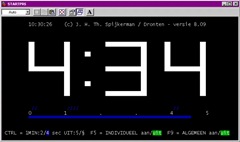Perfect weather for a perfect sailing event!
With a sunny sky, a steady breeze from the south-east and good forecast, we had two very good racing days in Langweer. As always, it has been very tiring and busy, but entirely satisfactory.
Like I told you yesterday, we tested a new program my brother has been developing this year on an old laptop. On the screen the countdown to the start in big numbers (so all on the upper deck can follow the sequence), a blue ribbon for five minutes and several options. For example the "CTRL-button" switches between a two seconds horn for one minute or a four seconds horn. I asked my brother to send me a screen picture to show to you:
127 boats in 14 classes, six individual recalls and one general. only one OCS. My regatta report gets more accurate by the year. The laptop not only gives the commands to the horn, it also keeps track of it's keystrokes in a log which looks like this:
30/08/2008 14:00:00 class 1 START
30/08/2008 14:05:00 class 2 START
30/08/2008 14:09:16 class 2 SIGNAAL 2x
30/08/2008 14:25:00 class 3 START
30/08/2008 14:30:00 class 4 START
30/08/2008 14:35:00 class 5 START
30/08/2008 14:45:00 class 6 START
30/08/2008 14:49:36 class 6 SIGNAAL 2x
30/08/2008 15:00:00 class 6 HERSTART
30/08/2008 15:05:00 class 7 START
30/08/2008 15:05:20 class 7 Terugroep INDIVIDUEEL
30/08/2008 15:10:00 class 8 START
30/08/2008 15:15:00 class 9 START
30/08/2008 15:20:00 class 10 START
30/08/2008 15:30:00 class 11 START
30/08/2008 15:35:00 class 12 START
30/08/2008 15:40:00 class 13 START
30/08/2008 15:45:00 class 14 START
Complete log: logboek LW08
A very good beginning, but now I want more! I want the prep and the one minute. I want to be able to type the OCS's into the report and other information as well, which I now record by hand:
You'll notice a few discrepancies in the log: The restart of class 2 is missing after the first "signaal 2x", signaling postponement. And 20 seconds for a horn to indicate individual recall is entirely too long! Not because we were late deciding, but because the keyboard is not that reliable anymore.
He's demanding a new laptop already! <G> and you know what, I want to give it to him as well, because I see the benefits already.
Mike B has send me an email with a link to another sailing program:
"Please check out www.innovation-tech.co.uk. I use their Sailing Event Controller" I will have to check that out.
For now I don't want to spoil my brother's tinkering, he has too much fun doing this and doing a great job to boot! Well done, Jan!











